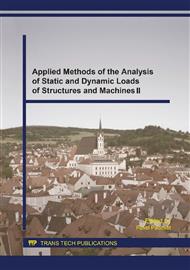p.121
p.125
p.129
p.133
p.137
p.141
p.145
p.149
p.157
Numerical Model of the Static Loading of a Stitched Seam in the Composite Cover of Car Seat
Abstract:
Fundamental knowledge of the mechanical properties of used materials are the basic preconditions for a successful construction of a final product. For seam as well as the reliability of its strength in some cases we need to know certainty when there will be the malfunction. In this study a spun of polyester thread were sewn on a material used for car seat cover. A single or multiaxial loading either static or dynamic has been used in the field of automotive textiles as well as for conventional materials. There is no standard method of measurement for the determination of dynamic strength of sewn seams and therefore it was necessary to construct a device that may measure the strength of seams under dynamic stress. It was carried out an experimental determination of the tensile strength under a static and shock loading for the textile part itself, then for the thread and also for them all together. A lot of very sophisticated numerical models of the individual materials structures in the world generally exist but considerably less is in this field taken into account the behavior of the whole.The aim of this work is with using the commercial software ANSYS create a contact numerical model that will be able to predict behavior of stitched seams and can be used instead of the classical experiments.
Info:
Periodical:
Pages:
137-140
Citation:
Online since:
February 2016
Authors:
Keywords:
Price:
Сopyright:
© 2016 Trans Tech Publications Ltd. All Rights Reserved
Share:
Citation:


